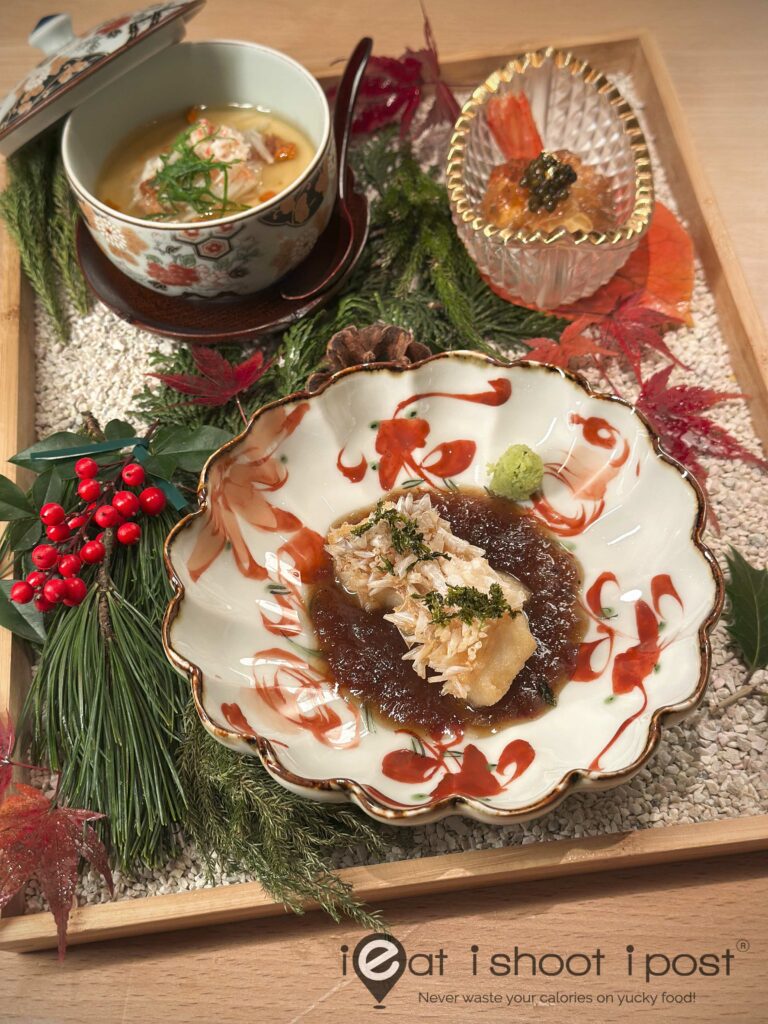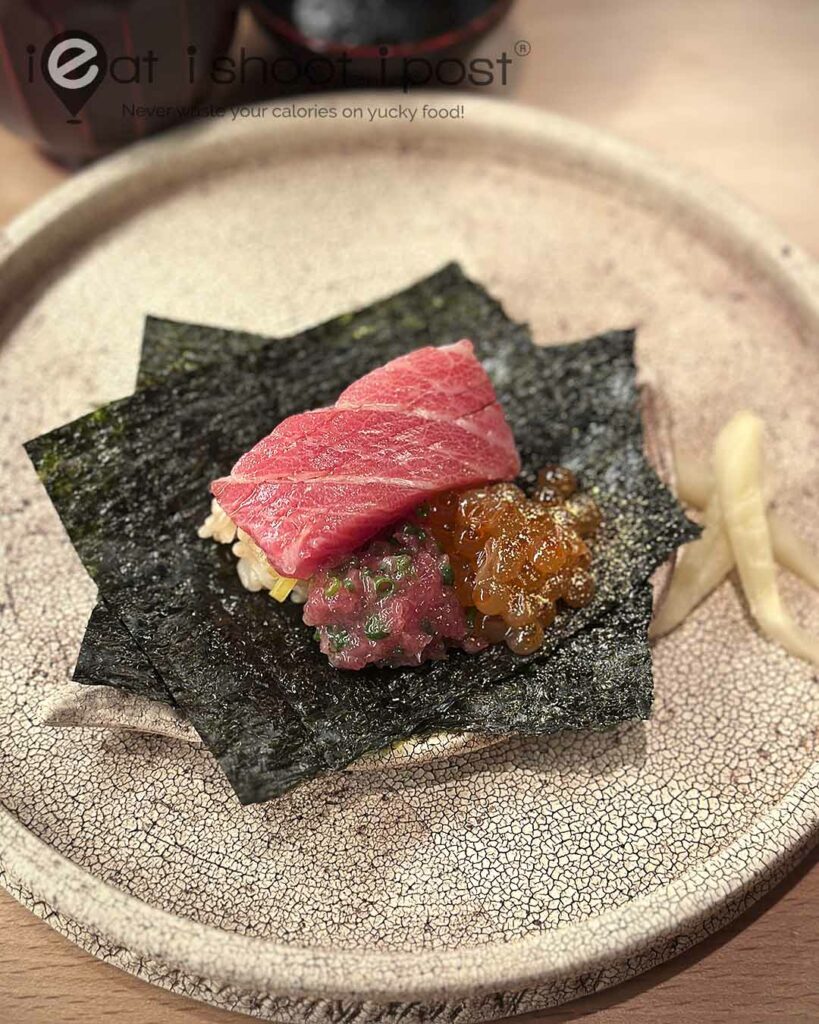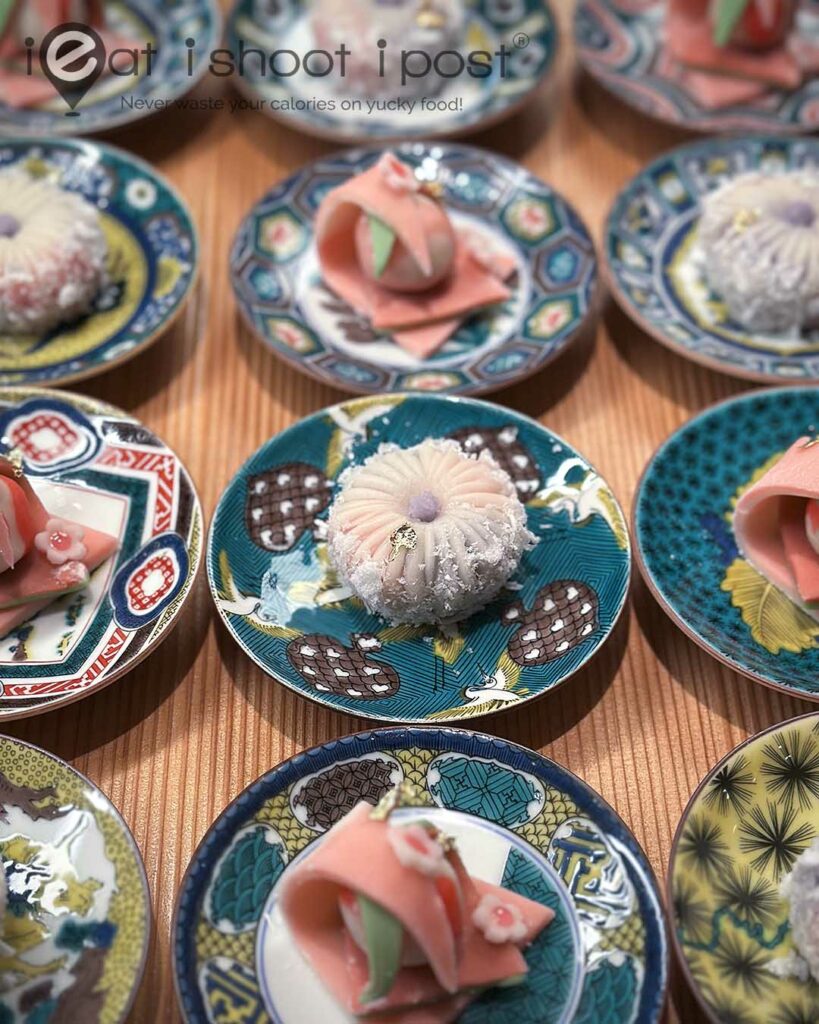
An omakase meal in Japan is a dining experience where the customer entrusts the chef to select and prepare the dishes. The term “omakase” (おまかせ) means “I leave it up to you” in Japanese.
A defining feature beyond showcasing the finest seasonal ingredients handpicked by the chef, is the element of surprise. Guests are invited to savour the anticipation and curiosity of what the chef will create next. The chef’s skill lies not only in the preparation but also in reading the guests and crafting dishes that delight and captivate using the ingredients available.
If that is the definition, then I can’t say I’ve ever truly experienced an omakase meal in Singapore. Here, an omakase meal is more akin to a degustation menu. While it still features the finest seasonal ingredients and the chef may make some last-minute adjustments, it lacks the free-flowing spontaneity I envision as pivotal to a traditional omakase experience.
The Singapore-style omakase has gained significant popularity in recent years, with many new restaurants offering their own “omakase” menus. But Hachi Restaurant was well ahead of the trend, having established itself in 1999 at an unassuming location in Orchard Plaza. Over the years, it has moved through various locations, spending nine years at Mohamed Sultan Road before moving to the National Gallery of Singapore six years ago. With a history spanning over 25 years in Singapore, Hachi remains a pioneer in this dining concept.
Unfortunately, the future of Hachi Restaurant remains uncertain as they are still in the midst of negotiations to renew their lease at the National Gallery of Singapore (as of December 2024). Relocating to their current location six years ago at the invitation of the National Gallery, Hachi Restaurant invested approximately S$2 million in the new space. But, they had to face the challenges brought on by the COVID-19 pandemic less than two years after opening. Now, just two years after the pandemic, with their future lease still in question, this winter’s Omakase menu could potentially be their last.
It seems that Hachi Restaurant is not alone in facing this challenge. It has been reported that the One Michelin Star restaurant, Art, was also unable to renew its lease and has already moved out. And so has Gemma and Smoke and Mirrors. It’s truly disheartening to see a restaurant with a 25-year history being forced to shutter for such a reason. However, there’s still time to celebrate Hachi Restaurant’s legacy, so if you’re a fan, be sure to visit while you can!
Premium Winter Ingredients

As you walk into the restaurant, you will undoubtedly be impressed by their attention to detail. Everything, from its authentic décor to its carefully sourced ingredients, exudes a distinctly Japanese character.
This accomplishment is truly a labor of love. The chef and his team travel to Japan multiple times a year to discover new ingredients and select artwork to enhance the restaurant’s ambiance. Over the past 25 years, they have also amassed an exquisite collection of artisan-crafted flatware from all over Japan. They are the same team behind the very popular Public Izakaya, which has become our go-to izakaya. We absolutely love the authentic food and ambiance there.
Early Winter Omakase Menu
As winter sets in, Hachi is showcasing the seasonal ingredients through their lunch and dinner omakase options. Lunch prices range from $168++ to $188++ while dinner options are from $238++, $318++ and $398++.
You may make reservations via their Instagram page or google maps where there is a link to their booking page on Sevenrooms.
If you are making a reservation for a special occasion like birthdays or anniversaries, do indicate in the remarks. That way, their in-house dessert chef Yamamoto-san can prepare something special for the occasion.
Premium Ryu Omakase Menu $398++
Here are the courses included in the Ryu Omakase Menu:
Hassun

Wintertime is an exceptional time for crabs and other seafood as they have fattened up to prepare for the colder months. We were presented with three dishes to usher in the winter season together with seasonal plants like the nanten (heavenly berries) which is an evergreen with red berries that appear in winter.
We began our meal with tilefish, a delicacy that reaches its peak in winter. Known as amadai (甘鯛), or “sweet sea bream,” this fish thrives in colder waters, enhancing its flavor and texture during the season. Its delicate scales, when fried to a crisp, add an extra layer of texture to the dish. This is perfectly complemented by the sweetness of the accompanying tamanegi onion sauce.
The botan ebi was elegantly served with a jelly crafted from prawn heads and topped with a delicate layer of caviar. The prawn’s natural sweetness harmonized beautifully with the umami richness of the jelly and subtle saltiness of the caviar, creates a perfectly balanced dish. Of special note is the cut glassware (Edo Kiriko) that is was presented in.
The Zuwaigani snow crab from Ishikawa Prefecture was beautifully presented in a chawanmushi. Sourced specifically for their roe, the female crabs are at their peak during the winter season. Adding a unique touch to the dish was yurine, the edible bulb of the lily. It is an uncommon ingredient for Singaporean diners that brought an unexpected and delightful element to the experience. (see photo)
Sushi

For the sushi course, we were served two pieces of sushi. While uni has always been one of my favourite toppings, this time it was overshadowed by the Kan-buri. It is a winter yellowtail and highly sought-after delicacy when the fish is at its fattiest and in peak condition. The beautifully marbled piece of fish was lightly kissed by charcoal, enhancing its flavor, and it was truly exceptional.
Ankimo

Ankimo is the liver of the monkfish, often referred to as “the foie gras of the sea” due to its rich, buttery texture and deep flavor. In Japan, ankimo is a highly regarded dish, especially during winter. Its richness aligns with the seasonal desire for hearty, warming food. It is often featured in celebratory meals or fine dining settings.

Although we’ve enjoyed ankimo many times before, this was our first experience having it as a paste.
The liver is first steamed, then pressed through a fine mesh sieve and mixed with seasonings to create a smooth, creamy texture. It paired wonderfully with the hirame, whose firm, chewy texture provided a delightful contrast to the creaminess of the ankimo, while the shiso, cucumber, and daikon provided crunch and a bright herbal fragrance.
Agemono

For the deep fried dish, we were served deep fried shark’s fin. We were intrigued at first as it really looked like the fried tapioca cake that you can buy from the goreng pisang stall. They turned out to be fresh school shark’s fin which were by-catches of the commercial fishery. The whole shark is not wasted as they eat the meat and the rough skin is used to make wasabi graters.
The fins were first braised in a flavourful stock till soft, then batter and deep fried. Paired with sudachi lime, the result is a crispy outside with intriguing crunchy strands of cartilage within.
Sashimi

The highlight of the sashimi was undoubtedly the Kegani.
Kegani (毛蟹), or hairy crab, is a prized delicacy in Japan, known for its sweet, delicate meat and rich crab miso (kanimiso). Native to the cold waters of Hokkaido, it is one of the most sought-after varieties of crab in Japanese cuisine and is in season in winter.
The crab is small, making it a bit tedious to extract the meat from its shell. Thankfully, the chefs have already done the hard work. That leaves you to simply enjoy picking out the sweet, tender flesh from the carapace. It’s beautifully topped with its rich “kani miso” (crab tomalley) and paired with a homemade kani-su vinegar to cut through the richness of the tomalley.
Another highlight was the Sawara Sashimi (Spanish mackeral) that is cold straw smoked (Warayaki). The straw’s oils and smoke infuse the ingredients with a light, earthy flavor that cannot be replicated by other grilling methods.
Suimono

Instead of simply serving the Tarabagani (Red King Crab) straight, it was painstakingly used to make Shinjo Dumplings (真薯).
These are delicate Japanese dumplings often made with a smooth paste of fish or shrimp combined with soft binders like egg whites or tofu. They are prized for their soft, pillowy texture, making them a highlight of a Kaiseki course. Our shinjo was served in a suimono (clear soup) so you can savour the fresh, natural flavours of the seafood.

We are told that it was important that live Tarabagani crabs were used to make the shinjo as its delicate flavour cannot be achieved with the frozen variety. The crab was mixed with diced hotate to create a light seafood dumpling.
It reminded me of the Nonya dish, Bakwan Kepiting which is also made from crab meat, but the texture was more delicate and pillowy.
Yakimono

Although the key ingredients of the yakimono were the Miyazaki A5 wagyu and 48 hour miso marinated gindara, it would be a crying shame to overlook the accompaniments that were specially sourced to mark the season.
Firstly, we have Kuwai” (クワイ), the Japanese water chestnut. This is a type of aquatic plant often associated with Japanese New Year celebrations. Its edible corms are a symbol of good fortune and success, as the plant grows vigorously with strong pointed shoots that symbolize new growth and prosperity.
Next, we also have something that resembled tiny potatoes. These were Mukago (むかご) which are small aerial bulbils (tiny buds) of yam plants, particularly Japanese yams. They are cherished in Japanese cuisine for their nutty flavor and delicate texture. Mukago is considered a seasonal delicacy, especially in autumn, so we were fortunate to still be able to have them in early winter.
Although these two vegetables were not the main ingredients, they serve as symbols of the changing seasons and are seldom found in Singapore. Their inclusion highlights the team’s dedication to offering an authentic, seasonal menu to their patrons.
Finally, it’s worth noting the finely shredded Yama wasabi (山わさび), or mountain wasabi—a type of horseradish cultivated in the colder regions of Japan, particularly Hokkaido. Unlike true wasabi (Wasabia japonica), which grows in water, Yama wasabi thrives in soil. Its sharp, pungent flavor provides a perfect counterbalance to the richness of the A5 Wagyu.
Temaki

The temaki handroll features chutoro tuna belly and freshly chopped minced tuna. What sets this handroll apart is the inclusion of low-temperature cooked ikura roe, which adds a unique texture and flavor.
Hachi uses excellent nori produced by Mikuniya, a renowned premium nori manufacturer based in Japan. The company is known for its meticulous production methods and commitment to quality, often producing nori of the highest standards. We were amazed to see that it even came in a solid wooden box!
Dessert

Another feature that sets Hachi apart is that they have an in-house pastry chef, so you can expect more than the usual “seasonal fruits” and a scoop of commercial ice cream after the meal.
We were presented with two desserts. The first was an original Amazake Ice Cream with Kakeru Shoyu. Amazake is made from fermented rice used in sake production before fermentation occurs. Its sweetness comes from the natural sugars released as the rice carbohydrates break down. Traditionally served as a hot drink in winter, it was transformed into an ice cream and paired with a sweet shoyu sauce and pistachios.

The final dessert was a wagashi which Dessert Chef Yamamoto crafted to celebrate the end of the year and the upcoming New Year. This intricate wagashi features a harmonious blend of beans, soft mochi, and kudzu, which provides a delicate and chewy texture.
The addition of fresh strawberries brings a hint of sweetness and vibrant color, while the aromatic perilla leaves add a refreshing, herbal note that balances the sweetness of the other ingredients. This thoughtful combination captures the essence of seasonal ingredients, making it a perfect way to mark the transition into the new year.
Restaurant Design

The ambience at Hachi is warm and inviting. The hinoki wood theme, distinctive wall pieces, and curated collection of Japanese antiques all contribute to an authentic atmosphere. A great deal of thought went into the restaurant’s design, right down to the precisely positioned mirror. Constructed at just the right angle, it allows patrons who aren’t sitting at the counter to observe the chefs at work. But more importantly, it allows the chef to see if the diners are enjoying the food!
Handmade Artisan Flatware

Hachi Restaurant has one of the most extensive collections of artisan flatware (plates) that we have come across in Singapore. The flatware, be it wood, ceramic or glass is mostly handmade in Japan and includes specialized ceramic styles from different prefectures including Kutaniyaki, Kyoyaki, Minoyaki, Imari, Shigarayak and Tsuboyaki, just to name a few.
It costs on average S$1,800 worth of flatware to present one person’s dinner at the table and the entire inventory is estimated to be worth S$600,000!
Conclusion
At the time of writing, Hachi restaurant has not yet managed to renew its lease at the National Gallery. As such, there is a good chance this might just be our last chance to experience the Winter Omakase meal at one of Singapore’s pioneer Omakase restaurants!
Disclosure: this post is written in partnership with Hachi Restaurant.











